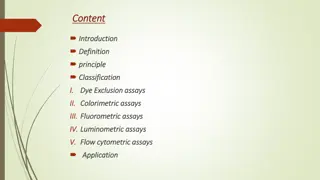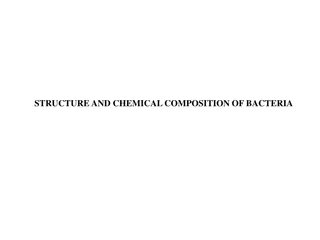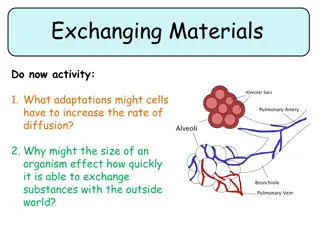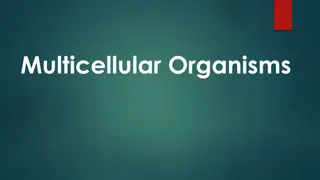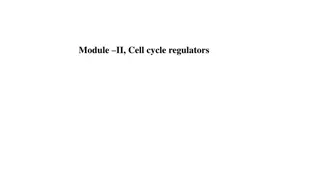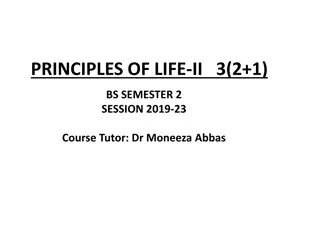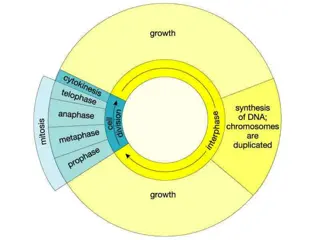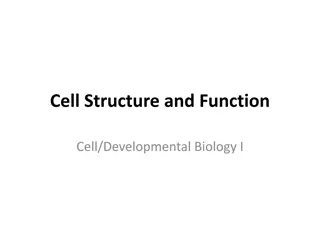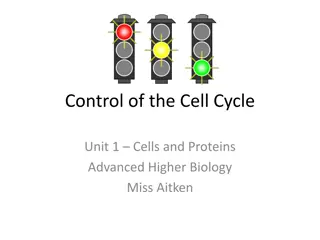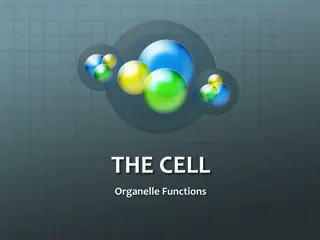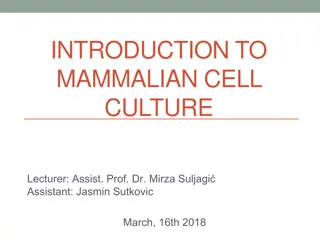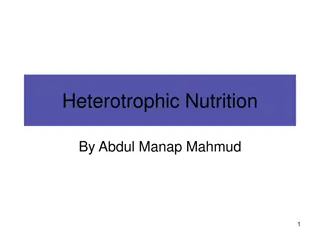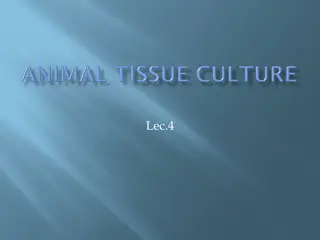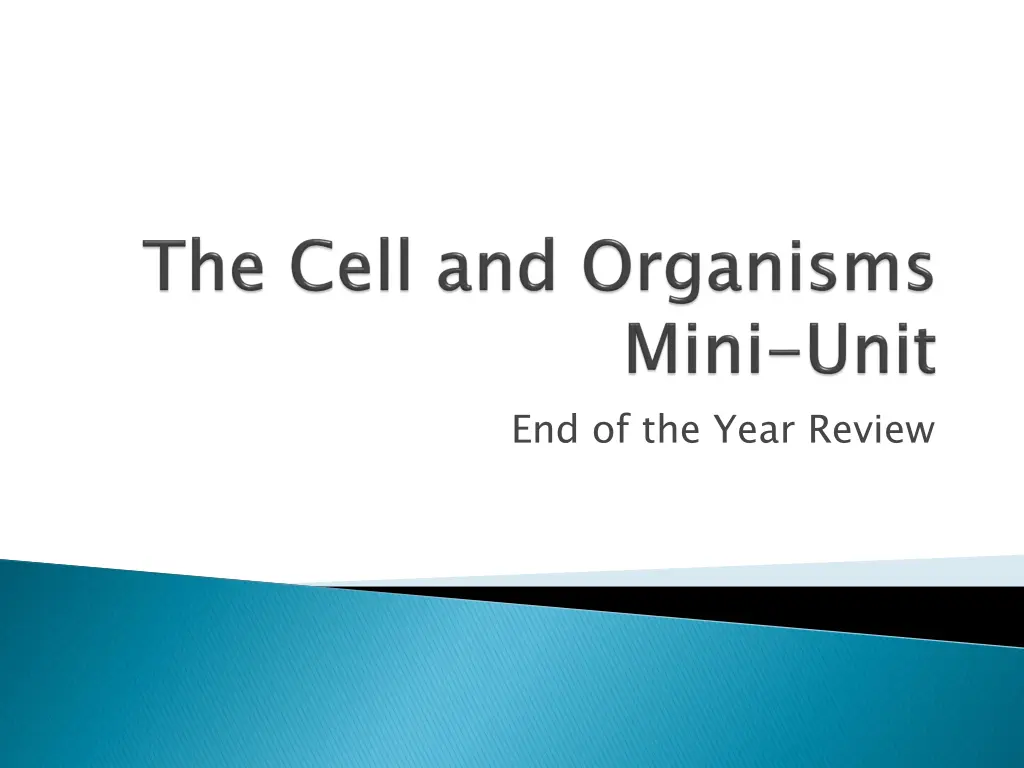
Year-End Cell Biology Insights
Explore the fascinating world of cells through this end-of-the-year review. Delve into the history of cell discovery, the fundamentals of cell theory, the importance of cell shape, cell types, and the essential components that make up a cell. Gain insights into the structure, function, and diversity of cells in organisms. Discover the significance of membrane-bound organelles, cytoplasm, and more in the intricate workings of cells.
Download Presentation

Please find below an Image/Link to download the presentation.
The content on the website is provided AS IS for your information and personal use only. It may not be sold, licensed, or shared on other websites without obtaining consent from the author. If you encounter any issues during the download, it is possible that the publisher has removed the file from their server.
You are allowed to download the files provided on this website for personal or commercial use, subject to the condition that they are used lawfully. All files are the property of their respective owners.
The content on the website is provided AS IS for your information and personal use only. It may not be sold, licensed, or shared on other websites without obtaining consent from the author.
E N D
Presentation Transcript
________________= organism made of one cell ________________= organism made of multiple cells The ____________________ was used to discover the first cell Lens Light Microscope SEM Scanning electron microscope TEM transmission electron microscope
First scientist to identify and name cell= __________________________________ Studied cork First to view live cells = ____________________________________ Developed cell theory = ______________________________________
Cell theory states that: All living things are made of one or more __________ Cells are the basic unit of _____________________and function in organisms Cells come from __________________________ Cells vary in size from 2 meters to .2 micrometers Better to have a large Surface Area compared to Volume Otherwise hard to import enough nutrients to fuel the cell if too large
It is an advantage for a cell to have a _________________________ shape Increases surface area The shape can tie into the function eg. WBCs Why is shape important for WBCs? __________________________________________________
Two main types of cells: _________________________ have membrane bound organelles and a nucleus Plants, animals, fungi, protists __________________________ have neither a nucleus nor membrane bound organelles Bacteria Separated into 6 ___________ Bacteria, fungi, animalia, plantae, protista, archaea 1 step more specific than domain
Cells are made of a jelly-like substance, ________________________, surrounded by a thin layer, __________________________. Most cells have _____________________, that do specific functions for the cell like organs in humans Within the cytoplasm both metabolism and transport take place
Large organelle that controls the cells metabolism and contains _______________ DNA in ___________________ Control Center because it directs the cell s activities _______________ = The storage sacs in the cytoplasm Some are specialized to digest food, others to get waste out of the cell In plants, hold lots of water and are much bigger than in animal cells.
___________________ = Lots of tiny structures that are important for making proteins Some are attached to membranes in the cell Nuclear membrane, rough endoplasmic reticulum Others float around in the ________________ ___________________= are pod-shaped structures that contain special proteins, known as _____________ used to extract energy from nutrients Known as the _____________________ of the cell because they release most of the cell s energy through the life process_____________________
_________________ = Green structures found in plants and some one-celled organisms They contain green pigment ______________ ,capture light energy, which is then used to produce food for the plant through life process_____________________ Not in animal cells. ________________________ = Continuation of the nuclear membrane that is used to make lipids and proteins. With Ribosomes = __________________________________ Without Ribosomes = ______________________________ _____________________=Involved in secretion and intracellular transport Packaging and Transport center
Thin outer lining of a cell It is made of mainly fats (_________________), with some _______________________scattered throughout. Function of the membrane: Separate the inside of the cell from the outside Controlling the transport of materials (like waste) into and out of the cell Recognizing and responding to chemical signals Has 4 layers Hydrophobic Hydrophilic Hydrophilic Carboxyl Hydrophobic Carboxyl Glycerol Glycerol
Forms a protective barrier ________________= fats Gated Channels = Open and close for certain molecules Carrier molecules = Aid in the movement of materials through the cell membrane _________________= Allow water to flow through _____________________ Model = Made of many smaller pieces that are held together and are always in motion
Plants, most bacteria, and fungi have a ___________________outside of the membrane. Made of a carbohydrate called ____________________. It gives the cell strength and rigidity If a plant cell absorbs too much water the membrane could burst, the cell wall helps to stops this. A cell needs things from the atmosphere Molecules can enter or leave the cell through either ______________or ___________________ Oxygen, nutrients must pass through the membrane of the cell through _________________________ Water moves through ______________________________
Moving a molecule from an area of __________ concentration to an area of __________ concentration requires energy Energy in the form of ______________ _____________ -________________ Pump = # 1 active transport system in the body Without it, our response time would be slower Pump moves 3 Na+ions out of the cell and 2 K+ ions into the cell against the concentration gradients Leads to an electrochemical gradient across the cell membrane that is important for nerve impulses and resulting movement
Two types of ________________that help One protein extends through the membrane Another is imbedded at the glycerol layer Some act as carrier molecules that allow the passage of only one type of molecule ___________________movement = Carrier Molecule that can open and close for a specific molecule ________________ = Movement that requires no energy, moves from high concentration to low concentration until it is evenly distributed One of the most important molecules to diffuse is ______ Without it cannot have homeostasis
____________________= Cell membrane slowly wraps around a molecule or another cell and pulls it inside White blood cell and bacteria Phagocytosis = ingestion of solids into the cell through endocytosis ___________________= the ingestion of liquid into the cell through endocytosis ____________________ = When a cell membrane gets rid of waste or protein that has been packaged by the golgi body by unwrapping around it
Molecules too big to enter cell are broken down through the process of ________________ Proteins are broken down into smaller molecules known as ______________________ Starches are digested into __________________ We need to digest things because only the smaller molecules (amino acids and simple sugars) can enter a cell or blood vessel Once inside, molecules come together and form building blocks of compounds This is known as _____________________ The building blocks are made into complex things like proteins, starches, DNA Not all nutrients are used in building blocks. Some nutrients are broken down even more for the energy = _____________________________
_____________________ molecules = Some proteins in the cell membrane can receive chemical messages from other cells. How cells communicate between themselves. Chemicals made in the endocrine glands, ____________________, and other chemicals made by nerve cells
Plant Cells have: ________________________________ ________________________________ ________________________________ Middle Lamina Animal Cells have: _________________________________
The structural organization of organisms is shaped like a pyramid Organism
_________________ system = One-way passage Includes: Mouth, stomach, intestines and other organs Food enters through the mouth, broken down ____________________by chewing and chemically by saliva Moved through the body by muscle contractions Rest of the food is eliminated from the body as waste _________________ system = uses oxygen to break down molecules (from food) to release energy Exchanges gases between the blood and environment Takes in ___________________for cell respiration and transfers it to the blood Removes ___________________________ Lungs and nose do most of work
_____________________ System = Involves movement of molecules into the cell and between cells; transport materials throughout the body Carries digested food & oxygen to the cells; waste from the cells to the lungs, kidneys & skin to be excreted; proteins to attach foreign substances Includes the ____________, blood vessels, and blood __________________ System = The removal of waste produces from cells of the body Includes lungs, kidneys, and sweat glands in the skin
_________________ & ________________ Systems = Interaction allows for movement of the body Support for the body Allows body to avoid danger, find food, mates, and shelter _________________& _________________System = control coordination of the body s activities Work together to send messages to cells throughout body The nervous system sends signals along _____________ The ______________of the endocrine produce chemical messengers (hormones) to travel in blood The brain and nerves are part of the nervous system The endocrine has glands pancreas, ovaries, testes
_________________ System = The ability to resist disease ________________________________engulf and destroy invading bacteria or viruses by digesting them Others protect the body against specific foreign invaders _________________ System = Organisms produce new organisms of the same kind Releases sex cells and hormones that are needed for the creation of offspring and then its development ______________ reproduction = two organisms create an offspring that is not identical to either parent
The organ systems in the body are continuously interacting Nutrients from _______________system are transported to the cells through the circulatory system Reproductive system is regulated by hormones from the ________________system Body temperature drops, nerves in the brain signal the muscles to shiver, generating warmth Blood sugar is constantly regulated by hormones to keep it balanced. If one organ system is not working right then the entire organism could fail. Because it is not maintaining ______________________
Function Function Single Cell Single Cell Multicellular Organism Respiratory system _____________ _____________ Digestive system Excretory system Multicellular Organism Gas Exchange _____________ _____________ Cytoplasm Transport of substances Nutrition _____________ _____________ _____________ _____________ Excretion


